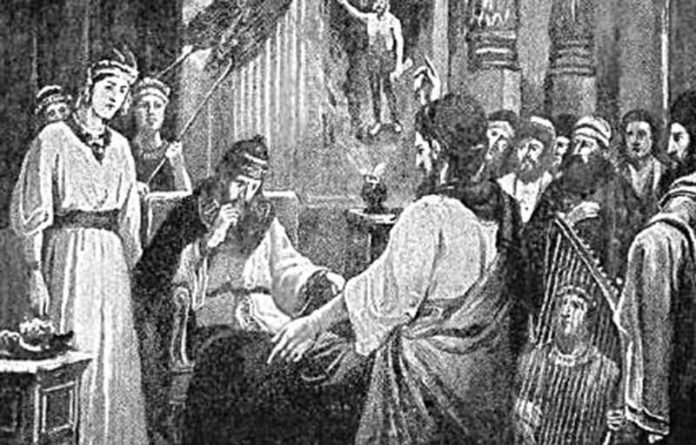King Nebuchadnezzar II conquered Jerusalem and forced the inhabitants into exile. Here, they were able to fill the gaps in their own tribal stories of the creation story.
Nebuchadnezzar was the son of Nabopolassar, the Chaldean restorer of Babylonian independence. King Nebuchadnezzar II (605-562) was the most important king of the second or Neo-Babylonian Empire. Nebuchadnezzar restored old religious monuments and improved canals as other Babylonian kings had done, but Nebuchadnezzar is best known for his Hanging Garden of Babylon, one of the seven wonders of the ancient world.
Jewish Exile in Babylon
Nebuchadnezzar defeated Cimmerians and Scythians and then moved west conquering wastern Syria, and destroying Jerusalem. He took the inhabitants prisoner and brought them to Babylon. It is referred to as the Babylonian Captivity.
On the 15th and 16th March 597 BCE, Nebuchadnezzar captured the king of Jerusalem and appointed a new puppet king called Zedekiah. The true king Jehoiachin, was carried into exile with all his court and the intellectuals of the land, the idea being that those who remained would not have the wit to raise a rebellion against their new masters.
It is probable that over three thousand people were taken to Babylon; cuneiform tablets found at Babylon, list payments of oil and grain to the captives, naming specifically king Jehoiachin and his five sons as recipients.
The fact that Jehoiachin had not been put to death made many Jews believe he would be allowed to return, and there is evidence this may well have been Nebuchadnezzar’s original intention. The new puppet king was not as docile as the Babylonians had imagined and he was tempted to side with Babylon’s enemy, the Egyptians, in order to liberate Judah. At first he followed the advice of his supporters and caused his masters no difficulty.
Unfortunately pro-Egyptian pressures in his court forced a rebellion in 589 BCE, this immediately prompted Nebuchadnezzar to attack the cities of Judah. In the following January the siege of Jerusalem began. Zedekiah knew there would be no mercy this time and he held out for two and a half years, but despite an attempt by Egyptian forces to drive off the Babylonians, the city fell in July 586 BCE. Jerusalem and its temple was utterly destroyed.
Zedekiah was brought before Nebuchadnezzar at Riblah in Babylonia where he was forced to watch the killing of his sons and as he stared in horror his eyes were plucked out. With this last terrible sight burned into his memory, the puppet king was carried off to Babylon in chains. According to Jeremiah 52:29 a further eight hundred and thirty-two people were taken into exile at the same time.
To the exiles from Judah, Babylon must have been a marvelous place to behold. It was a cosmopolitan city that spanned both banks of the Euphrates in the form of a square, said to measure fifteen miles by fifteen miles. The Greek historian Herodotus visited the city in the fifth century BCE and described its grand scale, with its gridwork of perfectly straight roads and buildings that were mostly three or even four storeys high. He claimed that the city walls were so wide that a chariot with four horses could be driven along them, and recent excavations have shown this to be completely true.
Babylonian Influence
For the deported priests and nobles of Jerusalem, this new existence must have been very strange. They must have felt gratitude they had not been put to the sword and sorrow for the loss of their land and Temple.
The whole way of life in Babylonia would have been alien, but they soon found that the theology was surprisingly similar. Their own Egyptian/Caananite based legends and those of the Babylonians derived from a common ancient Sumerian source, and the Jews soon found that the gaps in their own tribal stories of the creation and the Flood could now be filled in.
While most of the Jews got on with life as it came to them, a small number of the deportees were philosophical and fundamentalist priests from Solomon’s Temple. They sought to rationalise the situation as best they could. It is now generally accepted that most of the first five books of the Bible were written here, during the Babylonian captivity. Using information about the beginning of time from their captors, the Jews were able to reconstruct the way that God had created the world and mankind, as well as gain details about later events such as the Flood.
Nebuchadnezzar was an important king in the Neo-Babylonian Empire, who created a cosmopolitan and stunning city. Their own creation story was similar to the Jewish theology as both were heavily influence by Sumerian legend. The Jewish exiles were able to fill in the gaps of their own tribal stories.
Source:
- Lomas, Robert and Knight, Christopher, The Hiram Key, Arrow Books, London, 1997








